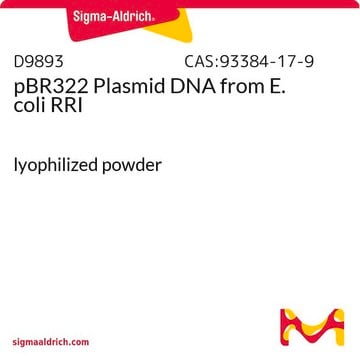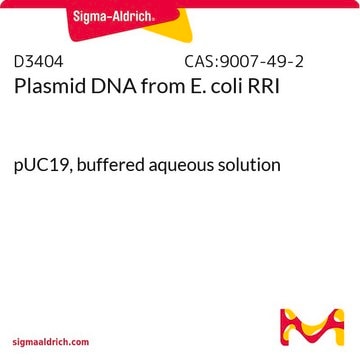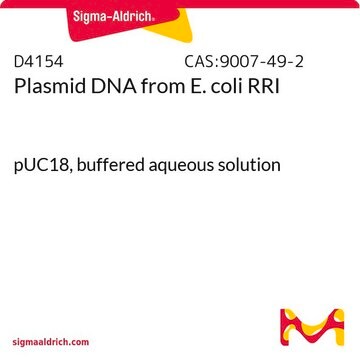D4904
pBR322 Plasmid DNA from E. coli RRI
buffered aqueous solution
Sign Into View Organizational & Contract Pricing
All Photos(1)
About This Item
CAS Number:
EC Number:
MDL number:
UNSPSC Code:
12352200
eCl@ss:
32160414
NACRES:
NA.51
Recommended Products
recombinant
expressed in E. coli
Quality Level
grade
for molecular biology
form
buffered aqueous solution
mol wt
2.9 MDa
4363 bp
origin of replication
BR322
selection
ampicillin
shipped in
dry ice
storage temp.
−20°C
Looking for similar products? Visit Product Comparison Guide
General description
Plasmid pBR322 was one of the first multipurpose cloning vectors constructed for use in E. coli. This plasmid is derived from the ColE1-type plasmid pMB1 and shares the same type of replication mechanism and controls as ColE1 and relatives. Plasmid pBR322 confers resistance to ampicillin and tetracycline. The plasmid sequence has been published.
The plasmid has unique restriction sites within the gene for ampicillin resistance (Pst I, Pvu I, and Sca I), within the gene for tetracycline resistance (BamH I, BspM I, EcoR V, Nhe I, Nru I, Sal I, Sph I, and Xma III), and elsewhere (Aat II, Ava I, Bal I, Bsm I, BspM II, Cla I, EcoR I, Hind III, Nde I, Pvu II, Ssp I, Sty I, and Tth111 I).
The plasmid has unique restriction sites within the gene for ampicillin resistance (Pst I, Pvu I, and Sca I), within the gene for tetracycline resistance (BamH I, BspM I, EcoR V, Nhe I, Nru I, Sal I, Sph I, and Xma III), and elsewhere (Aat II, Ava I, Bal I, Bsm I, BspM II, Cla I, EcoR I, Hind III, Nde I, Pvu II, Ssp I, Sty I, and Tth111 I).
Specificity
Unique Sites: Within the gene for ampicillin resistance: Pst I, Pvu I, Sca I; Within the gene for tetracycline resistance: BamH I, BspM I, EcoR V, Nhe I, Nru I, Sal I, Sph I, Xma III; other unique sites: Aat II, Ava I, Bal I, Bsm I, BspM II, Cla I, EcoR I, Hind III, Nde I, Pvu II, Ssp I, Sty I, Tth111 I.
Application
Plasmid pBR322 was one of the first multipurpose cloning vectors constructed for use in Escherichia coli. This plasmid and derivatives have been used for a number of purposes including cloning, selection and expression of recombinant molecules, construction of shuttle vectors and vectors for nucleotide sequencing, studies of elements involved in gene expression, as plasmid DNA standards, and as a model system for studies on prokaryotic plasmid replication.
pBR322 Plasmid DNA from E. coli RRI has been used to study about ferrous ion-induced strand breaks in the plasmid pBR322 are mediated through hydrogen peroxide.
Biochem/physiol Actions
This plasmid is derived from the ColE1-type plasmid pMB1 and shares the same type of replication mechanism and controls as ColE1 and relatives.
Components
DNA is provided in a solution of 10 mM Tris-HCl (pH 8.0) with 1 mM EDTA.
Other Notes
Accession number: J01749
related product
Product No.
Description
Pricing
Storage Class
11 - Combustible Solids
wgk_germany
WGK 3
flash_point_f
Not applicable
flash_point_c
Not applicable
ppe
Eyeshields, Gloves, type N95 (US)
Certificates of Analysis (COA)
Search for Certificates of Analysis (COA) by entering the products Lot/Batch Number. Lot and Batch Numbers can be found on a product’s label following the words ‘Lot’ or ‘Batch’.
Already Own This Product?
Find documentation for the products that you have recently purchased in the Document Library.
Ferrous ion-induced strand breaks in the DNA plasmid pBR322 are not mediated by hydrogen peroxide
Flemmig J and Arnhold J
European Biophysics Journal, 36(4-5), 377-384 (2007)
Jörg Flemmig et al.
European biophysics journal : EBJ, 36(4-5), 377-384 (2006-10-19)
Ferrous ion-induced generation of single and multiple strand breaks in the DNA plasmid pBR322 induces the formation of two new plasmid forms with altered electrophoretic mobility. The yield of these plasmid forms, the circular relaxed and the linear forms, depended
Charles J Addison et al.
BioTechniques, 37(3), 376-378 (2004-10-09)
Transformation of Escherichia coli plays an important role in recombinant DNA technology. Most current transformation protocols require that the cells be treated to attain a particular physiological state known as "competence," and this makes transformation procedures lengthy and arduous. Here
Our team of scientists has experience in all areas of research including Life Science, Material Science, Chemical Synthesis, Chromatography, Analytical and many others.
Contact Technical Service








